Learning Objectives:
You should be able to:
- explain how bacteria reproduce and the potential effects of a short vs. a long generation time on the production of disease.
- describe the different forms of bacterial growth and how each form relates to disease production or laboratory diagnostic procedures.
- describe how a bacterial growth curve is generated, what it looks like, and the 4 major phases.
- explain the difference between the results of a direct cell count vs. a viable cell count.
- list the minimal growth requirements for bacteria and explain how these requirements can affect classification and choice of lab tests.
- define: obligate aerobe, obligate anaerobe, and facultative anaerobe.
- describe the function of catalase and superoxide dismutase.
- define fermentation and explain its importance in lab diagnostic tests.
- state whether facultative anaerobes grow faster under aerobic or anaerobic conditions and explain why.
- describe the general way in which bacterial surface structures are synthesized and assembled.
- describe the basic steps in peptidoglycan synthesis and identify which steps are inhibited by antibiotics.
OVERVIEW
The growth requirements and types of growth exhibited by pathogenic bacteria affect the way in which they produce disease, for example how quickly and where in the human body. It is important to know that specific bacteria have different growth requirements so that specimens are collected, processed, and cultured appropriately. Understanding bacterial growth, metabolism and biosynthetic processes has also been critical for developing effective antibacterial agents.
Photo by Internet Archive Book Images






Leave a Reply